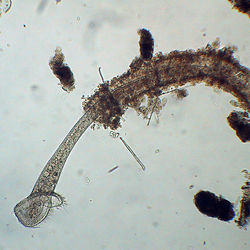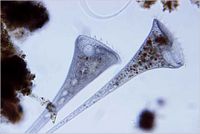Stentor: Difference between revisions
No edit summary |
No edit summary |
||
| (6 intermediate revisions by 2 users not shown) | |||
| Line 1: | Line 1: | ||
{ | {{Curated}} | ||
{{Biorealm Genus}} | |||
[[Image:stentor8.jpg|thumb|250px|right|''Stentor muelleri''. [http://www.pirx.com/droplet/gallery/stentor.html Photo by Pitor Rotkiewicz. ]]] | [[Image:stentor8.jpg|thumb|250px|right|''Stentor muelleri''. [http://www.pirx.com/droplet/gallery/stentor.html Photo by Pitor Rotkiewicz. ]]] | ||
| Line 17: | Line 15: | ||
''Stentor polymorphous'' | ''Stentor polymorphous'' | ||
''Stentor roeseli '' | ''Stentor roeseli '' | ||
{| | |||
| height="10" bgcolor="#FFDF95" | | |||
'''NCBI: [http://www.ncbi.nlm.nih.gov/Taxonomy/Browser/wwwtax.cgi?mode=Tree&id=5962&lvl=3&lin=f&keep=1&srchmode=1&unlock Taxonomy] Genome ''' | |||
|} | |||
==Description and Significance== | ==Description and Significance== | ||
| Line 28: | Line 31: | ||
==Cell Structure and Metabolism== | ==Cell Structure and Metabolism== | ||
[[Image:stentor6.jpg | [[Image:stentor6.jpg|thumb|200px|right|''Stentor coeruleus'' in swimming form. [http://www.nies.go.jp/biology/mcc/strainlist_a.htm#Anabaena][http://www.pirx.com/droplet/gallery/stentor.html Photo by Pitor Rotkiewicz.]]] | ||
Cilia mainly cover the rim of the trumpet. In this way, ''Stentor '' resemble ''[ | Cilia mainly cover the rim of the trumpet. In this way, ''Stentor '' resemble ''[[Vorticella]]''. However, ''Stentor'' also have horizontal rows of cilia on the rest of the body to allow it to swim. Contraction and extension are controlled by two longitudinal fiber systems that are found in the cell cortex. They are called km fibers and myonemes. The primary photosensor is called stentorin. The macronucleus is an important feature of ''Stentor''. It resembles a string of beads, consisting of nodules held together by cytoplasmic bridges. | ||
''Stentor ''are omnivorous heterotrophs. Typically, they feed on bacteria or other protozoans. Because of their large size, they are also capable of eating some of the smallest multicelluar organisms, such as rotifers. | ''Stentor ''are omnivorous heterotrophs. Typically, they feed on bacteria or other protozoans. Because of their large size, they are also capable of eating some of the smallest multicelluar organisms, such as rotifers. | ||
| Line 37: | Line 40: | ||
==Ecology== | ==Ecology== | ||
[[Image:stentr00.jpg|thumb|200px|left|''Stentor'' spp. [http://www.micrographia.com/specbiol/protis/cili/hete0100.htm Micrographia, "Heterotrich Ciliates."]]] | |||
''Stentor'' usually inhabit freshwater environments. They ingest and form photosynthetic relationships with algae, causing them to have a blue or green color. | ''Stentor'' usually inhabit freshwater environments. They ingest and form photosynthetic relationships with algae, causing them to have a blue or green color. | ||
| Line 43: | Line 48: | ||
Research done on ''Stentor ''illustrates that these organsisms can escape from tubes with increasing frequency after multiple trials. It was suggested that this behavior might be associative learning. However, Hinkle and Wood (1994) illustrated that this was not the case. Because they changed tubes and media from trial to trial, this diproved the original hypothesis. ''Stentor'' escapes are learned behavior, but nonassociative. | Research done on ''Stentor ''illustrates that these organsisms can escape from tubes with increasing frequency after multiple trials. It was suggested that this behavior might be associative learning. However, Hinkle and Wood (1994) illustrated that this was not the case. Because they changed tubes and media from trial to trial, this diproved the original hypothesis. ''Stentor'' escapes are learned behavior, but nonassociative. | ||
==References== | ==References== | ||
Latest revision as of 15:14, 7 August 2010
A Microbial Biorealm page on the genus Stentor

Classification
Higher order taxa
Eukaryota; Alveolata; Ciliophora; Heterotrichea; Heterotrichida; Stentoridae
Species
Stentor coeruleus Stentor polymorphous Stentor roeseli
|
NCBI: Taxonomy Genome |
Description and Significance
Stentor are classified within the phylum Ciliophora. They are referred to as heterotrichs because they have different cilial structures on different parts of their bodies. Stentor are among the largest aquatic protozoans.Up to 2 mm long, they are larger than some of the smallest multicellular organisms. Stentor usually attach to substrates and form a trumpet shape. If they are free-swimming, they assume an oval or pear shape. A major characteristic of Stentor is the rapid contraction and extension of the cell body.
Genome Structure
There is not yet an extensive body of research on the genome structure of Stentor.
Cell Structure and Metabolism
Cilia mainly cover the rim of the trumpet. In this way, Stentor resemble Vorticella. However, Stentor also have horizontal rows of cilia on the rest of the body to allow it to swim. Contraction and extension are controlled by two longitudinal fiber systems that are found in the cell cortex. They are called km fibers and myonemes. The primary photosensor is called stentorin. The macronucleus is an important feature of Stentor. It resembles a string of beads, consisting of nodules held together by cytoplasmic bridges.
Stentor are omnivorous heterotrophs. Typically, they feed on bacteria or other protozoans. Because of their large size, they are also capable of eating some of the smallest multicelluar organisms, such as rotifers.
Stentor typically reproduces asexually through binary fission. They can also reproduce sexually via conjugation.
Ecology

Stentor usually inhabit freshwater environments. They ingest and form photosynthetic relationships with algae, causing them to have a blue or green color.
Stentor coeruleus exhibits a behavior called photodispersal. These organisms swim away from light and prefer to inhabit dim areas. To escape light, Stentor coeruleus reverses the direction of its ciliary beat to change direction and reorient itself.
Research done on Stentor illustrates that these organsisms can escape from tubes with increasing frequency after multiple trials. It was suggested that this behavior might be associative learning. However, Hinkle and Wood (1994) illustrated that this was not the case. Because they changed tubes and media from trial to trial, this diproved the original hypothesis. Stentor escapes are learned behavior, but nonassociative.
References
The Ciliate Resource Archive. "Stentor." Accessed 27 June 2005.
Micrographia. "Heterotrich Ciliates." Accessed 27 June 2005.
Rotkiewicz, Pitor. Droplet: Amateur Microscopy of the Protozoa.
Walker, Dave. "Protozoa - The Stentor." Micscape Magazine. Accessed 27 June 2005.

